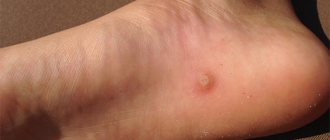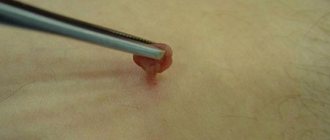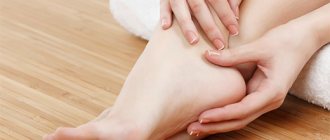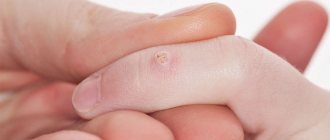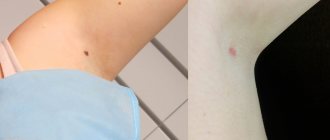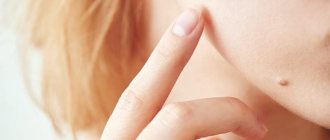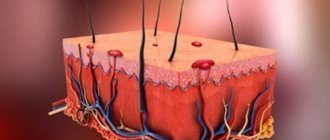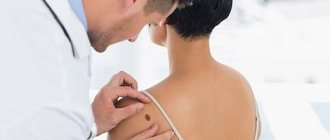Pigment spots on the body do not always have an aesthetic appearance, and their ability to degenerate into malignant tumors is not at all encouraging. How to get rid of a birthmark, and what removal methods are best to use? Most people prefer to contact qualified specialists, but there are people who remove annoying stains on their own at home. What traditional medicines are successfully used during such a procedure?
It is quite acceptable to eliminate birthmarks yourself using “folk” methods.
Indications for mole removal
Before starting treatment, you must visit a doctor and undergo a diagnostic examination. A dermatologist will examine you and determine the best way to remove the nevus. It is not recommended to perform surgery if a cancerous tumor is suspected, during an exacerbation of chronic diseases, if there is a history of cardiovascular diseases, or if herpes rashes appear.
Moles are removed in the following cases:
- frequent injury, rubbing of the nevus with clothing items (moles on the soles, neck, palms, waist, scalp);
- pedunculated moles are excised, as they can become twisted and easily damaged;
- when changing shape, size;
- if the nevus appeared in adulthood in people over 50 years of age;
- location of a large mole on the face.
If you suspect the development of melanoma, additional consultation with an oncologist is required. The main signs of a cancerous tumor are: ulceration of the surface, discharge of ichor, pain on palpation, rapid growth of the tumor, change in shape and blurred boundaries with the surrounding skin.
Which nevi cannot be removed
It is forbidden to burn moles with celandine if they are located on the mucous membranes, in the genital area, on the neck, or eyelids. In case of color change, appearance of black nodules, cracks, signs of inflammation, discharge of ichor, formation of crusts on the surface of pigmented nevi, you should immediately consult a doctor. Such symptoms indicate malignant degeneration, and attempts to remove the growth can lead to accelerated formation of a cancerous tumor - melanoma.
Electrocoagulation
How to get rid of moles on the face and body? The electrocoagulation method is based on exposure to high-frequency currents. During excision of the nevus, the blood vessels are cauterized, which eliminates the development of bleeding and the formation of edema. The operation is performed under local anesthesia using a special device - an electrocoagulator, equipped with a loop heated by current.
Useful properties of celandine
The healing plant effectively cleanses the skin thanks to the unique chemical composition of active ingredients:
- Alkaloids (cholerithrine, homochelidonine) in large quantities can cause the development of inflammation, in small dosages they have an antiviral, cauterizing effect, and relieve pain.
- Succinic, malic, and citric acid accelerates exfoliation of the upper keratinized layer of the dermis, has anti-inflammatory, antibacterial properties, and increases local immunity.
- Carotene protects the skin from the negative effects of ultraviolet radiation and maintains its elasticity.
- Vitamin C has an antioxidant, lightening effect, stimulates the immune defense of soft tissues, and strengthens small blood vessels.
- Tannins have astringent properties and form an invisible film that protects against the penetration of bacteria and fungi. Relieves inflammation, irritation, itching.
For treatment, shoots of fresh, dry plants, the underground part or juice are used. The finished concentrated extract can be purchased at the pharmacy.
Cryodestruction
How to get rid of moles on the body? You can painlessly and quickly get rid of nevi using cryodestruction. This is a method of excision of skin tumors using liquid nitrogen, which cools pathological tissues to very low temperatures (-196°) and causes them to die.
The tip of the device is directed to the removal site and the mole is cooled until a white spot appears within 2-3 minutes. Freezing of intracellular and intercellular fluid occurs, vital processes in the treated tissues cease, destruction and death of the dermis is observed.
The procedure is painless, the patient experiences a slight tingling, burning sensation, and mild pain may occur. After freezing, local swelling forms and lasts up to 3 hours. Then bubbles appear on the surface of the nevus, necrosis develops after another day, and the tissues are rejected on their own within 2–6 weeks. Complete tissue regeneration lasts about 6 months.
Recipes with celandine
In summer, the plant can be used fresh by picking the plant and applying the cut to the mole. There are recipes with celandine, prepared from dried raw materials, which are prepared and dried independently according to the recommendations for drying herbs: out of sunlight, in a ventilated area, in the oven.
Celandine is included in various products, each with its own expiration date and method of application. Biologically active substances, organic acids and flavonoids contained in the stems and leaves of the plant can destroy cell structure, help relieve the inflammatory process, accelerate tissue restoration, and dry out damage. However, the process of prolonged exposure to a nevus with a product that contains celandine carries the risk of the cells degenerating into malignant ones. It is difficult to predict the process and probability; the choice of method for removing skin defects should be left to the doctor:
- Celandine juice is used to remove moles in the summer as follows: wipe the nevus and the area around it with a disinfectant, rinse off the residue with water. Then apply a thick cream to the area around the formation to protect healthy skin from burns. Apply the thick end of the freshly cut stem with the orange juice oozing out to the mole, hold for 10-15 minutes, repeat the procedure 2 times a day. The duration of the course is from 2 weeks to a month. If you grind the plant, squeeze the juice out of it, dilute it in alcohol or vodka in a 2:1 ratio, the shelf life of the product when stored in the refrigerator is up to 12 months. An alcohol solution of celandine juice is used according to the same scheme;
- The tincture is made from dry plant raw materials, purchased at a pharmacy or made with your own efforts. 50 g of raw materials are poured with a glass of alcohol and put in a dark place for a week. After the specified time, filter the tincture, drop 10-12 drops into half a glass, and drink 2 times a day after meals. The tincture is also used for local external treatment of moles with a cotton swab, avoiding contact of the product with healthy skin. The therapeutic effect occurs after 10-14 days of regular use;
- Ointment based on celandine is prepared independently, using a dried, powdered plant or freshly squeezed juice. The raw materials are mixed with lamb fat, baby cream, cosmetic petroleum jelly in a 1:2 ratio, stored in the refrigerator, and the mole is treated 4-5 times a day, leaving the product until absorbed.
You can remove defects on the skin with a decoction of celandine, which is prepared and added to the bath, and a more concentrated decoction cauterizes nevi. The product should be applied pointwise.
Laser removal
How can you safely remove moles without leaving scars on your skin? The most popular and effective procedure is laser surgery. This method of therapy is based on the evaporation of fluid from tissues and coagulation. Cauterization of the dermis and blood vessels avoids bleeding and promotes rapid regeneration without the formation of scars.
Laser mole removal does not require direct contact with the skin, thereby eliminating the risk of infection. Exposure to a carbon dioxide ray can be carried out even on areas with the most sensitive skin, eyelids, lips. The procedure is painless; for people with a low sensitivity threshold, local anesthesia is used.
Contraindications to laser mole removal:
- cancerous tumors;
- diabetes;
- epilepsy;
- autoimmune diseases;
- increased body temperature;
- pregnancy and lactation period.
The rehabilitation period after laser removal lasts 4–10 days. Complete excision of moles less than 3 mm in diameter is carried out in one procedure, leaving no scars or pigment spots on the skin.
Consequences after using celandine
Incorrect, uncontrolled use of folk remedies can cause various complications:
- chemical skin burn;
- inflammation and suppuration of the wound after the scab falls off;
- allergic reaction;
- formation of scars.
Negative consequences in most cases are observed when celandine is applied excessively and the juice gets on healthy tissue. If a burn occurs, you must immediately rinse the skin with clean water, dry it with a cotton towel and treat it with Panthenol. It is contraindicated to continue cauterization until the wound heals.
It is not recommended to independently remove moles with celandine without first visiting a dermatologist-oncologist. The doctor will determine the etiology of the tumor, eliminate the possibility of developing a cancerous tumor and recommend the optimal treatment methods, which will not leave scars.
Pharmacy drugs
How to get rid of a large mole on the face at home? Getting rid of growths is allowed only after examination and consultation with a dermatologist, possibly using pharmaceutical ointments to remove unwanted nevi. Uncontrolled self-medication can lead to an inflammatory, infectious process and more serious complications.
In pharmacies you can purchase the following products for removing moles:
- Stefalin ointment is made from natural plant ingredients. The composition of the drug does not cause allergic reactions; the active ingredients are able to penetrate into the deep layers of the dermis and cause tissue destruction. Ointment for removing moles contains extracts of celandine, burdock, aspen, Yakut, and anemone. The medicine is applied once a day for 1 week.
- Lapis pencil has a cauterizing, necrotizing and bactericidal effect. The mechanism of operation of the drug is based on the ability of silver to suppress the growth and reproduction of pathogenic microorganisms, which prevents the development of the inflammatory process. The mole is lubricated 1-2 times a day until it is completely removed; treatment should not be carried out too often, this can lead to tissue burns.
- We get rid of moles at home using Verrucacid. The drug causes coagulation of protein structures and has a cauterizing effect. When applied topically, the ointment for moles and papillomas promotes exfoliation of the keratinized area, has antibacterial properties, and accelerates tissue healing.
- Cryopharma is a means for carrying out cryotherapy and removing moles on the body at home. It is enough to apply the drug to the problem area once; if necessary, repeat the procedure after 2 weeks.
Types of moles and their features
More than 50 types of nevi are known to medicine, but in dermatology and oncology classification is used according to three main parameters: type, time of occurrence and size. In terms of size, formations can be small, medium, large and giant. Giant moles can exceed 10-15 cm in diameter and are most often localized on the back and face.
Indications for mole removal
Based on the time of occurrence, congenital and acquired nevi are distinguished. Congenital moles are quite rare. In most newborns, punctate nevi on the skin are absent or so small that it is impossible to see them in the first months of life. Acquired formations differ in the location of melanocyte accumulation:
- in the upper layers of the skin (epidermal);
- in the deep layers of the dermis (intradermal);
- between the dermis and epidermis (borderline).
Signs of a dangerous mole
The classification of moles by appearance and type is presented in the table below.
| Type of mole | Characteristic |
| Nevi | Flat spots of brown and black. Can be located on any part of the body with predominant localization on the surface of the face |
| Blue nevi | A formation with a smooth surface in the form of a small nodule, having a dense and elastic consistency. The diameter of blue nevi does not exceed 1 cm. They are located singly and have a characteristic black-blue color |
| Angiomas | A benign tumor in which small blood vessels or lymphatic vessels grow under the skin |
| Lentigo | Pigmented spots that are light brown or dark brown in color and have an oval or oblong shape |
Differences between a malignant mole and a benign one
When can exposure to iodine cause harm?
The danger of using the drug is hidden in the consequences. There are reasons why you should not use this type of cauterization:
- The solution has a stimulating effect on blood circulation, provoking rapid growth of the nevus. Triggers the process of cell degeneration into a malignant tumor.
- There is a risk of burns and can cause serious complications.
- Infection and the onset of an inflammatory process are possible.
- Due to the coloring properties of the product (the brown color resembles the natural color of birthmarks), it becomes difficult to observe a benign nevus. You can skip the process of transformation into a malignant tumor.
Modern medicine has provided safe ways to remove unwanted formations on the body, without harm to health. Nevi, warts, and papillomas can be removed using laser, radio wave, cryotherapy, and surgery. The excision is painless and leaves no marks or scars. Re-removal is not required except in rare cases.
If there is the slightest change in a mole: itching, burning, color or shape, size have changed, you should not pick and treat the nevus yourself, especially cauterize it.
Before visiting a doctor, it is not advisable to smear the mole with iodine - this affects the natural color of the formation and complicates diagnosis.
Do not forget also about the contraindications for removing moles with iodine. These include:
- allergic reaction to the liquid or its components;
- during pregnancy, breastfeeding;
- children under three years of age;
- chronic diseases of the thyroid gland, kidneys, and liver;
- increased sensitivity to the product;
- pulmonary tuberculosis;
- if the formations are located in dangerous areas (faces, eyelids, mucous membranes, intimate areas).
The effectiveness of using ointment to eliminate moles
Warts and papillomas, moles, and benign formations of different shapes and colors appear on the surface of every person’s skin. Most lesions are caused by the human papillomavirus.
Papillomas are often confused with moles, and attempts are made to remove them using the same methods. This is wrong, it is better to remove nevi using hardware techniques, and the result of the presence of HPV can be safely cauterized.
Papillomas, warts, condylomas, and moles on the body should not be ignored. Formations are often damaged and increase in growth. There are the following methods of disposal:
- the surgical method involves removing the mole with suturing;
- cryotherapy – treatment of a disease by freezing;
- electrocoagulation – burning out growths using electric current;
- laser therapy – cleansing the skin using a laser;
- creams, ointments, gels, balms for removing pigmentation and tumors.
Asymmetrical, different-colored and large-sized moles should be removed without fail. If there are bleeding and growing growths, an analysis of the contents should be done to determine whether degeneration into melanoma has occurred.
The mole removal cream effectively copes with the task, does not leave large scars or burns, and is gentle on the skin. The cream for eliminating growths can be bought at a pharmacy at an affordable price, and thanks to the clear instructions, it is easy to use. Before you start burning out nevi at home, you should consult a dermatologist.
Dangerous sun.
For each person, the critical duration of exposure to sunlight is highly individual. It’s not easy to determine this line, so it’s better to just remember that prolonged exposure to the sun is harmful to the body. The skin is forced to protect itself from ultraviolet radiation. Excessive tanning means inevitable burns. If you love beach holidays so much that you simply cannot deny yourself this pleasure, at least listen to the following tips. By following these simple recommendations, you will not only improve your health, but also reduce the risk of a dangerous disease.
- Staying in the sun is safe from morning until 10 o'clock, in the evening after 17 o'clock.
- For people with a large number of moles, it is better to reduce their exposure to the sun.
- Try to avoid redness and sunburn on your skin. If this happens, spend 2-3 days in the shade.
- After swimming in the sea, be sure to rinse your skin with fresh water.
- Even young and healthy people can spend no more than one and a half to two hours a day in the sun.
- Taking certain medications increases the skin's sensitivity to light. Please consult your GP before going on holiday.
- Use sunscreen cosmetics: at the beginning of the holiday, the indicator should be maximum, about 40 units.
- Do not use decorative cosmetics, deodorants and perfumes on the beach - they can cause the appearance of age spots on the skin.
Complications
Often, with incorrect methods for removing benign growths, you can get a papilloma of abnormal size. Or get burns and deep scars on the body.
Celandine juice is very poisonous; if used incorrectly, the human body can begin a “struggle for survival”, the following are possible:
- frequent headaches;
- dizziness;
- abdominal cramps;
- stomach upset;
- inflammation of tissue near the mole;
- temperature increase.
It is important from the very beginning of cauterization of a mole to make sure that it is a non-cancerous formation.
Reducing a nevus is not an easy task. You should always take a thoughtful approach to self-medication, and even more so without first consulting a doctor.
Unattended moles.
Some types of moles can degenerate into one of the most malignant tumors - melanoma (skin cancer). The initial site of formation of most melanomas is congenital pigment spots and warty moles. How does this dangerous development begin?
For example, after damage, a person only notices how the color of the mole begins to change, it enlarges, cracks, turns into an ulcer, and sometimes into a tumor. Therefore, without panicking, pay attention to the above symptoms, especially the progressive enlargement of the mole and change in its color. If all these symptoms occur, immediately rush to the dermatologist. The unfavorable prognosis of melanoma dictates the need for regular monitoring by a doctor. In addition to irritant factors (ultraviolet radiation, trauma), the development of melanoma can also be caused by genetic and endocrine factors. However, in the first place is, of course, excessive exposure to the sun. Ultraviolet radiation in large doses causes irreversible changes in skin cells, greatly increasing the risk of their degeneration. Light-skinned and fair-haired, red-haired people with blue and gray eyes are most susceptible to the mutagenic effects of sunlight. Those at risk also include those who have a lot of freckles, age spots and moles.
How to reduce a mole with iodine
Knowing the rules for using the product, you can avoid unpleasant consequences and complications. For the procedure to be effective and safe, the formation must be cauterized in the following way:
- Do not dilute iodine, since the product will not reduce nevi faster;
- to increase the rate of penetration into the epithelium, it is recommended to steam the body before the procedure by taking a hot shower or bath;
- Before the procedure, apply a thick cream or Vaseline to the skin around the growth. This will help avoid damage to healthy areas of the skin;
- Do not apply a cotton pad or gauze soaked in solution to the formation for a long time. This is fraught with inflammation of the affected area, itching, burning, and redness;
- To avoid scars and cicatrices, it is not recommended to pick or tear off the resulting crust. It should peel off on its own;
Instructions for removing formations with iodine:
- before smearing a mole with iodine, treat the skin with an antiseptic or soap;
- Gently dry the treated area with a towel;
- to protect the skin, apply cream or Vaseline around the growth;
- soak a cotton swab in the solution;
- Apply pointwise to the formation, avoiding contact with healthy areas of the epithelium.
Treatment is done twice a day for two weeks. During this time, warts and moles dry out and fall off. Continue to smear the area until the growth dries completely. It is impossible to cauterize the mole with iodine; if you pick it up or tear it off, it is better to treat it with an antiseptic and consult a dermatologist about its possible removal. Treatment of a damaged nevus should only be done with the permission of a doctor.
It is not recommended to use the method for people with a low pain threshold and sensitive skin. Itching, burning, and redness may occur.
To combat papillomavirus, blue iodine is an effective remedy (sold in pharmacies under the name “Iodinol”). The drug is taken orally and is prescribed only by a doctor. Effectively destroys cells infected with the virus, blocking their further spread throughout the body, improves the functioning of the gastrointestinal tract.
